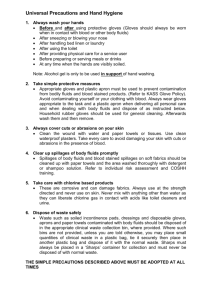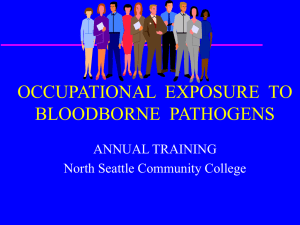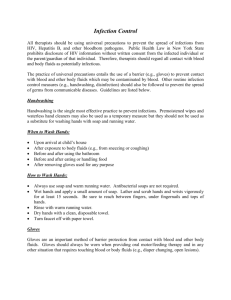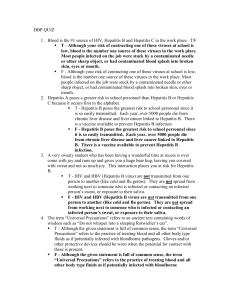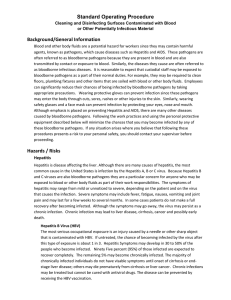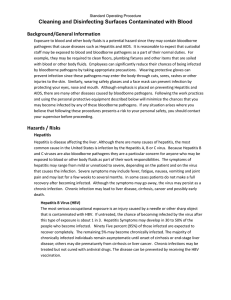sy 2014-2015
advertisement
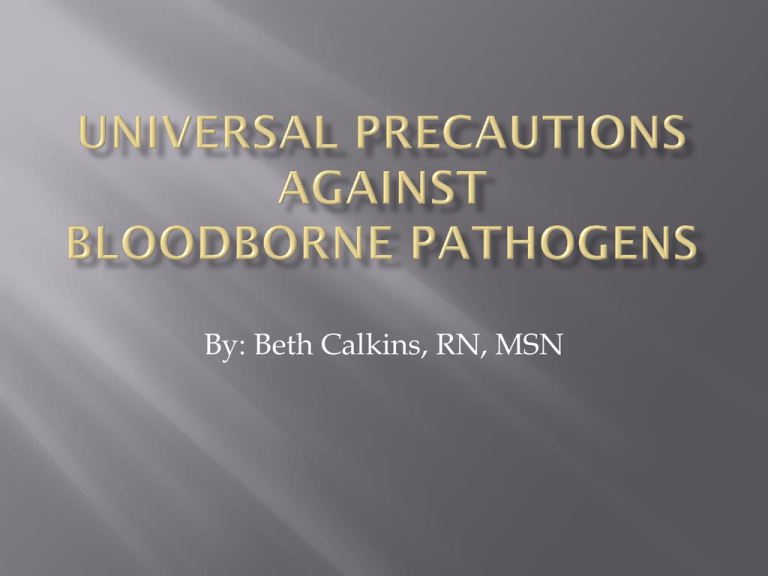
By: Beth Calkins, RN, MSN Employees working in a school system are potentially exposed to human blood and/or other body fluids containing human blood that may be contaminated with potentially infectious materials. Without the appropriate precautions, these potentially infectious materials may be transferred from one employee and/or student to another Bloody Nose Lost Tooth Bloody Lip Scraped Knee Biting Vomit Broken Glass in the Science Lab And Many Others Broken Skin Cuts Hangnails Dry, chapped skin Do you use hand sanitizer? Currently the No. 1 cause of dry, chapped hands If the answer to any of these is YES, then you are at risk for the following diseases! Hepatitis A Virus (HAV) Hepatitis B Virus (HBV) Hepatitis C Virus (HCV) Human Immunodeficiency Virus (HIV) Herpes, syphilis, malaria, MRSA (methacillin resistant staph aureus—staph that is antibiotic resistant) Not Bloodborne but body fluids (specifically fecal matter from an infected person) Usually transmitted through food prepared by an infected person Most children have no symptoms, although most adults are symptomatic for about 2 months Not chronic Common transmission in daycare centers 1% death rate (2% for those over 50 years of age) Vaccine is now available—Most of our students have gotten the vaccine. Have you? Causes serious liver disease 1.25 million infected in the U.S. 10% become chronically infected and remain so over their lifetime 50% have NO symptoms 5,000 people per year die of this disease Greater risk than that of HIV Vaccine is available / No cure Hep A—2 injections, 6 months—required to begin school, not all students have had the full series yet Hep B—3 injections over 6 months—required to start school Beaufort Naval Hospital Immunizations Clinic (Staff to check with School Nurse prior to going for certain immunizations only.) 228-5559 Military Dependents—Immunization Clinic open Monday through Friday from 0730am until 4pm Local Community Health Office or Health Dept. (small fee, usually $20 for visit plus $5 per immunization) 525-5915 Causes serious liver disease (#1 reason for liver transplants) 3 million infected in the U.S. 85% become chronically infected and remain so over their lifetime 75% have no symptoms for up to 30 years 10,000 people per year die of this disease Greater risk than that of HIV NO vaccine is available Beginning to find a cure through AIDs research / antiviral therapy (very expensive, lots of side effects) Hepatitis survives 7 days on a dry surface. HIV survives a few minutes. Clorox kills both! Breaks down the immune system May develop into AIDS (acquired immunodeficiency syndrome) 900,000 infected in the U.S. Number of deaths decreasing related to sophisticated treatments NO vaccine is available / NO cure Follow Universal Precautions: A system of infectious disease control that assumes that every direct contact with body fluids is infectious and requires every employee exposed to be protected as though such body fluids were infected with bloodborne diseases Wash hands frequently to reduce the risk of exposure Wear gloves if there is even a possibility you might have contact with another person’s body fluids After the removal of gloves or after exposure to blood or other potentially infectious materials, wash hands with antibacterial soap. Wear gloves once and discard. Do not use gels too frequently…they are drying and can crack skin Don’t wash hands with clorox or other antimicrobials Assume all blood or body fluids are contaminated and potentially harmful to your health! Blood Vomit Urine Feces (bowel movement) Saliva (spit, secretions from the mouth or lungs) Needles, syringes, or other Sharp instruments Soiled feminine hygiene products / sanitary napkins, soiled facial tissues, bandages, etc., are not considered biohazard or medical waste but you SHOULD wear gloves and wash hands with antibacterial soap after handling these. When: Before assisting with a medical procedure After physical contact with blood or body fluids After contact with soiled equipment After removing gloves How: Wet hands with running water Dispense cleanser on hands Wash vigorously for 15 seconds Rinse under running water Dry thoroughly Gloves—use Latex free gloves if you have a latex allergy Gowns Lab coats Mouthpieces Face shields Resuscitation Bags and Masks If exposed: Flush area / wash hands immediately REPORT IMMEDIATELY Handled similar to Workman’s Comp Immediate referral to medical personnel (ER or Preventative Med / Occupational Health) 6% to 30% (1 in 6) chance of getting Hepatitis B 2% to 10% (1 in 20) chance of getting Hepatitis C 0.3% (1 in 300) chance of getting HIV Wear protective gloves Mop up spill with paper towels or other absorbent material Clean using approved disinfectant such as 1:10 bleach solution Dispose of all contaminated materials in sealed, doubled plastic bags Sharps go in approved sharps container Body Fluid Spill Kit kept in the CUSTODIAL or Nurse’s Office DON’T pick up glass with hands Soak area in bleach x20 min Bleach solution must be less than 24 hours old Clean large spills by surrounding with bleach rather than pouring in and aerosolizing EXT. 2492 Fill out the following slide Print the slide (or get a blank one from the Nurse’s Office) Place the completed slide in mailbox of the appropriate person (Secretary, Nurse) This certificate from the Department of Defense Education Activity is awarded to _____________ on __________ for successfully completing the 2014-2015 Bloodborne Pathogen Training

